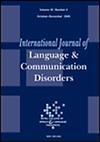Communication Patient Reported Outcome Measures for Adults With Communication Disorders: A Systematic Review of Content Validity
Abstract
Background
Content validity is a key measurement property that should be considered when selecting or reviewing a patient-reported outcome measure (PROM). In the field of communication disorders, there are several PROMs available, most of which are disease specific. It is unknown what the quality of the content validity of these PROMs is.
Aims
This study aimed to evaluate the content validity of existing communication PROMs used with adults with communication disorders.
Methods
This study evaluated PROMs drawn from a previously published systematic literature review. Of 31 measures, 25 measures were included in this review, covering a range of communication-related constructs in different communication disorders. The process of rating followed the COnsensus-based Standards for the selection of health Measurement INstruments (COSMIN) methodology for assessing the content validity of PROMs. There were three stages to the evaluation process comprising Step 1: evaluating the quality of the PROM development, Step 2: evaluating the quality of content validity studies on the PROM (if available) and Step 3: evaluating the content validity of the PROM overall, based on the quality and results of the available studies and the PROM itself.
Main Contribution
Step 1: With regards to the quality of the PROM development, 21 of 25 PROMs were rated as inadequate. Step 2: Content validity studies were available for five of the PROMs. All of these studies were rated doubtful or inadequate. Step 3: The quality of the available evidence on content validity of the included PROMs was overall very low. Only the evidence on the content validity of the Communication Participation Item Bank (CPIB) and the Neuro-QoL (Quality of Life in Neurological Disorders) was rated as of moderate quality.
Conclusions
Results of this study highlight the scarcity of high-quality evidence on the development and content validity of PROMs that aim to capture the construct of communication. This review is a call to action for future PROMs to include both the target population and professionals in development and content validity testing, using rigorous methodology in the process.
WHAT THIS PAPER ADDS
- There are several patient reported outcome measures (PROMs) available for adult communication disorders. Many of these PROMs have been assessed on one or more psychometric properties, typically reliability and validity aspects. Content validity is often overlooked in research.
- Clinimetric and psychometric experts recommend content validity as the first and most important measurement property to consider when selecting a scale. This study is the first to provide a systematic assessment of the quality of content validity of communication PROMs used in adult communication disorders.
- Using measures with good content validity during outcome measurement ensures that researchers and clinicians capture constructs that are relevant and important to clients. It also ensures that the measures used are accessible to the clients and comprehensively address their needs.


 求助内容:
求助内容: 应助结果提醒方式:
应助结果提醒方式:


